When thinking of Brazil, most people think of caipirinhas on the beach, carnival and the Amazon. Brazil has so much more to offer however, including some beautiful national parks full of waterfalls. When visiting Brazil you’ll likely have a time schedule and with so much to see and do and the huge distances, sometimes you have to make choices. And I’m here to help you choose between some of the waterfalls in Brazil. Below I will compare the parks of Iguazu, Itatiaia, Chapada Diamantina, Jalapão and Chapada das Mesas, listed from South to North.

Some of the links on this site are affiliate links. I might receive a commission for purchases made through these links, which help support this site, at no additional cost to you.
Iguaçu – Foz do Iguaçu/Puerto Iguazú
Ok, so this one is not optional, you HAVE to go to Iguaçu. Iguaçu is absolutely amazing, wihout doubt the most amazing waterfall in Brazil. The national park is actually shared between Brazil and Argentina, so if you’re traveling to/from Argentina this is the perfect place to cross the border. Even if you’re not planning on going to Argentina next, you should still cross over to visit the Argentinian side of the park. For me, a visit to Iguaçu is not complete without visiting both sides and many say the Argentinian side is the best.
The main difference is that the Brazilian side offers one boardwalk which which gives you an overview of the waterfalls. The Argentinian side offers four walks, one goes through the jungle and is more for wildlife spotting and ends at a place where you can go for a swim. The other three bring you up close to the falls. You can also book a boat ride, bringing you even closer. Book the boat at the start or end of your day, so you’re not rushing from one end to the park to the next to make the boat, having to go back afterwards.
Covid restrictions – Note that the same entry requirements are valid for this border as all other borders. Check with the respective government what you need in order to cross the border.

Planning your visit to Iguaçu
In order to visit everything the Argentinian side has to offer, you’ll need at least a full day, The Brazilian side can be done in half a day. That being said, we happened to visit during the last weekend of the Brazilian holidays so the queues where huuuuge, like an hour to buy a ticket and 3 hours to take the bus (included with your ticket) from the ticket office to the entrance of the park. In the end we had to take a taxi to skip to line in order to be able to make our bus from the Argentinian side to bring us back to Buenos Aires. It seemed like they had slowed down the buses bringing you to the falls as there were too many people inside already, it was absolutely packed and almost impossible to move!
So moral of the story, avoid weekends and holidays if you can and weekends during the holidays even more. As the Argentinian side is bigger and offers more trails, people divide more and this side can handle the traffic better. But it’s still better to visit in quieter times if you can of course.
To give yourself plenty of time to visit the Argentine side, I would recommend staying in Puerto Iguazú on the Argentinian side the night before. So if staying 2 nights:
Option 1 – Start and end in Brazil, or continue on to Argentina
- Arrive in Foz do Iguaçu, stay overnight.
- Day 1 – Visit the Brazilian side, cross over to Argentina and stay in Puerto Iguazu
- Day 2 – Visit the Argentinian side and take the last bus back to Brazil/transport to your next destination in Argentina if continuing on here. Or just take it easy and spend another night here.
Option 2 – Start and end in Brazil
- Arrive in Foz do Iguaçu and continue on to the Argentinian side and stay here overnight
- Day 1 – Visit the Argentine side and either stay here overnight or take the last bus to Foz do Iguaçu
- Day 2 – Visit the Brazilian side and take transport to your next destination
Option 3 – From Argentina to Brazil
- Arrive in Puerto Iguazú and stay here overnight
- Day 1 – Visit the Argentinian side and either stay here overnight or take the last bus to Foz do Iguazú
- Day 2 – Visit the Brazilian side
Note that there are busses from Puerto Iguazú going to the entrance of the Brazilian side of the park, you don’t need to go to Foz if you’re not staying there.
There is luggage storage available in the park, so if you want to venture on after your second day without having to go back to where you came from, you can drop your luggage off there.

Transport Tip: Iguaçu is a little out of the way and transport in Brazil isn’t cheap. Have a look at domestic flights as well as busses.
Parque Nacional Itatiaia - Maromba
This national park is probably the least known on this list, despite its location close to Rio de Janeiro and São Paulo. We stayed in Maromba, which is even less known. It’s a small town with lots of posadas walking distance from some cool waterfalls. If you’re traveling the coast and want a break from the beaches, it’s a quick and easy ‘escape’.
Waterfalls
Poção is just out of town and here you can jump of a rock in the water. A little further you’ll find Cachoeira do Escorrega (Slide waterfall), where you can indeed slide of the waterfall. About 1.5 hiking from town, you’ll find Cachoeira dos Cristais (Crystal waterfall). On the way you can stop by Cachoeira Véu da Noiva (Bride’s Veil) and just before reaching dos Cristais, you’ll pass Cachoeira da Gruta (Cave waterfall). I liked dos Cristais the best, as it’s quieter being a little further away from town so fairly quiet and the hike is pretty as well. Make sure to download Maps.me for a map of the route. It’s pretty straightforward but there are a few parts where you’ll want to make sure you’re on track.
These are only a handful of examples, the area is actually full of waterfalls and towns to stay at so you’ll have plenty to explore if you’re not in a rush!

Peaks
I know it’s post about waterfalls, but if you love hiking you’ll enjoy yourself in Itatiaia as well. You can also hike up Pico das Agulhas Negras. You’ll see signs at Cachoeira do Escorrega pointing you in the right direction. We hadn’t gotten around to do this one, but heard it’s not an easy track, especially getting to the top. It’s a 5+ hour hike from town and you’ll be hiking 1500m up so consider camping a night and heading back the next day. There are a lot of other peaks around as well, with connecting paths so it’s a hikers paradise!
Chapada Diamantina - Lençóis
This national park got it’s name due to the many diamonds that were found here. Big scale excavations with machinery are now illegal, but some locals keep searching the traditional (manual) way. It’s not that common anymore to find diamonds anymore however, as most of the park has been searched already.
Here you can visit waterfalls, caves, rock paintings, viewpoints and there is multiple day hike going through a valley. The big plus that Chapada Diamantina has, is that some of the waterfalls are accessible from nearby towns, like Lençóis. Lençóis is a beautiful colonial town perfect to base yourself while exploring the park. From here you can walk to.
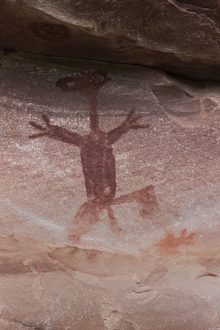
Waterfalls walking distance from Lençois
Ribeirão Meio
Ribeirão meio is a waterfall a short walk from town. It’s possible to slide of the waterfall, we’ve seen some locals do it. Looking at them bouncing of the rock did seem rather painful, so we did not attempt this. But they seemed to have fun! From here you can continue walking to Ribeirão de cima and Sossego

Mandassaia
Cachoeira Mandassaia is a little further away, but still walking distance from town. Note that it’s best to visit after some rain, when the waterfall is plentiful. It can dry up quite a bit and won’t be as pretty when it hasn’t rained for a while.

Serrano
Serrano was probably our favorite part close to Lençois. There are just so many colorful rocks, making it incredibly beautiful. It’s more of an area with waterholes, rather than a waterfall. Walk around exploring the area and find a nice waterfall to cool off in. It’s awesome, you definitely have to check it out when here. Do be careful with the waterholes as some of them have a strong current!
From here you can continue on to Salão de Areias, Cachoeirinha, Poço Haley Cachoeira da Primavera, Poço Paraiso and loop back via the lookout (Mirante) to Cachoeirinha.
There are some other trails going from Lençóis to other sights as well, but as they are quite far away you probably won’t make it in a day, so look into camping options if you don’t have transport and don’t want to go with a tour. Many of these aren’t recommended to do without a guide, so look into hiring a guide as well.
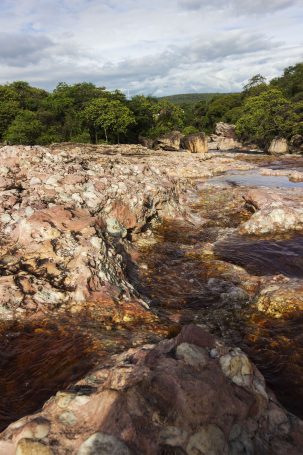
Guided tours from Lençois
Even though these places are great, they are not the highlights the park has to offer, in order to visit these you’ll need transport or a tour(guide). Guides can be contracted from the association, which can be found a block from the main square. Agencies are scattered around town.
Covid note: Most agencies are working only online and the few that still operate from their office are working at night (after 7pm). At the time of visiting, Morro do Pai do Inácio was closed.
Jalapão - Palmas
The cool thing that Jalapão has, are the fervedouros, ‘boilers’ translated to English. Unlike what the name suggests, the water isn’t hot. Fevedouros are waterholes where the water comes up. The pressure of the upcoming water generates bubbles, so it looks like boiling water. The water pressure prevents you from going down. It’s kind of like you float, but nothing like the dead sea or the salt lakes in San Pedro de Atacama for example. Other than that there are waterfalls, lookouts, dunes and a lake.
The distances between the sights in Jalapão are huge and roads are not in great condition. Especially in the rainy season roads are very, very difficult to drive. Most people take a tour which will take you around in a few days, most commonly 3-5 days but there are longer tours as well.
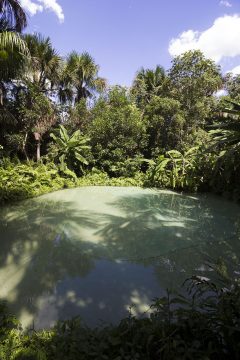
Jalapão by public transport
If you really want to visit some of Jalapão on your own, without your own transport, you can take the van going between Palmas and Mateiros (Transmateiros, +556399914642 Armando). This will allow you to see a little bit of what Jalapão has to offer.
They go twice a week, Tuesday and Friday leaving Palmas at 8am and arriving around 3-4pm in São Felix. From here you can visit the Bella Vista and Alecrim fervedouros, which are walking distance from town. The van goes back every Wednesday and Sunday (7.30-8.30, depending on road conditions). You can also make a stop a the Cathedral Ecolodge. From here you can hike up to the rock formation forming the cathedral (you’ll end up on the other side however, not above the cathedral), go for a bike ride and float in circles in a river with a circular current and go tubing.
If you’ve got your own transport, I can recommend staying for a night. Without your own transport this is going to be a little bit more difficult however due to the transport being so infrequent. You’d either have to miss out on the fervedouros and only visit the ecolodge or spend 4 days at the Ecolodge.
Your options with public transport are:
- 1 day: Leaving Palmas on Friday and coming back on Sunday
- 4 days: Leaving Palmas on Tuesday and coming back on Sunday or leaving on Friday and coming back on Wednesday.
- 6 days: Leaving Palmas on Friday or Tuesday
Option 1: Pick a place to spend one day
Leaving Palmas on Friday and coming back on Sunday. In this case I would recommend staying at São Felix to experience the fervedouros. The ecolodge has a cool concept, but if you only have one day, I’d recommend the fervedouros more.
Option 2: Pick a place and spend 4 days
Even though this is technically possible, I wouldn’t recommend it. You can visit the fervedouros in São Felix in one day, so no need to spend 4 (unless you want to avoid going on a Saturday at all cost). The ecolodge is pretty cool and will show you a very different side of Jalapão, but if you’re gonna spend 4 days there, I’d spend the extra 2 days and visit the fervedouros in São Felix as well.
Option 3: Visit both in 6 days
There are two ways to visit both in 6 days:
- Leaving Palmas on Tuesday: Travel first to the Ecolodge. Spend Wednesday and Friday here and travel to São Felix on Friday. Enjoy the fervedouros on Saturday and on Sunday head back to Palmas
- Leaving Palmas on Friday: Travel first to São Felix. Enjoy the fervedouros on Saturday and on Sunday travel to the Ecolodge. Spend Monday and Tuesday here and head back to Palmas on Wednesday.

Jalapão by tour
If you can, I would really recommend to visit with a tour however to make the most out of your visit and see the highlights that Jalapão has to offer. Prices only vary slightly amongst operators and you’ll be looking at about 500 rls (100 USD) per day for your tour.
Do note that many sights in Jalapão only allow short visiting times as it gets very busy. This combined with the big distances and poor road conditions means lots of time in the car and short visits. Bella vista for example normally only allows people to stay inside for 20 min. In peak-season you might also have to wait in line for hours as the fevedouro is only small.
As we visited in November 2020 we were lucky enough to enter without lines and enjoy the place for as long as we wanted, only sharing with a few other people.
If taking a tour to Jalapão I can recommend staying in Palmas for the night. You’ll most likely have to travel via Palmas either way and there are plenty of guides/agencies leaving from there so I wouldn’t bother going to Ponta Alta do Tocatins for example.
Palmas itself is a calm and green city. It doesn’t have a lot to offer for tourists, so you don’t need to plan a lot of time here. You can organize your tour online already, as most of the agencies that are listed online don’t seem to have an office and only operate online. We walked around for hours trying to speak to a few agencies and only found Fox. If you do end up spending a day here, there is a pretty river beach, you can visit an island in the river and spot lots of iguanas and birds (including Macaws).

Chapada de las mesas - Carolina
Chapada das Mesas got it’s name due to the flat mountains, which kind of look like tables (mesas in Portuguese). It offers some stunning sights and is one of our favorite waterfall places. The downside is that it is a little harder to reach than Chapada Diamantina for example and entrance fees are quite high (and excluded from tour prices). The upside of this is that it’s a little less visited. To visit the waterfalls you’ll also need either your own transport (in some cases 4×4) or a tour. If going by tour, I highly recommend going with Savanna Adventures. They’re are cheaper than the other agencies and the owners and guides are great. As a little extra they also provide cold water.
Eco Tip: To avoid using more plastic, bring your own bottle and ask to put it in the cooler rather than drinking from the small bottles.
Our favorite day trip was definitely Poço Azul! But we also enjoyed São Romão a lot. I recommend to do at least these tours and it’s possible to combine them with a sunrise at the Portal as well. Below the tour descriptions of the daytrips we did.
Poço Azul
This one is a must and includes three sites: Poço Azul, Cachoeira Santa Barbara and Encanto Azul. Poço Azul and Santa Barbara are located on the same terrain. You’ll have plenty of time to swim at Poço and to visit Santa Barbara (no swimming here). They’re only a short walk away from each other, so it’s easy to go from one to the other. Keep an eye out for wildlife here as we saw lots of lizards, birds and monkeys! At Encanto Azul it’s also possible to swim, but it’s a lot smaller than Poço Azul. Poço is overall nicer to spend a couple of hours chilling as well, so you’ll spend the majority of your time here.
Additional entry fees: 60 for Poço Azul (30 for students) + Santa Barbara & 30 for Entanco Azul (15 for students) = 90 rls (45 for students)
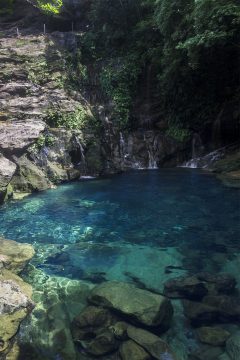
São Romão
The São Romão trip will take you to the waterfalls Prata and São Romão. Prata isn’t great for swimming due to the strong current. There is a rope however, which you can use to cross the water and get a better view over the waterfall. São Romão on the other hand is great for swimming. You can also take a kayak (included in the entry fee) to get pretty close to the waterfall. There is a path taking you up close to the side of the waterfall as well, which is really awesome. The feeling of so much energy right next to you is amazing! Yo can also get some cool pictures here. Be prepared to get soaked though!
Additional entry fees: 30 rls each (or 15 for students) = 60 rls (30 for students).

Portal
The most popular times to visit the Portal is during sunset or sunrise. The portal is only small and everyone will want to get there picture taken. So get in line, get a few shots and try to organize yourselves so that everyone can gather around at the same time and enjoy the sunrise/-set between pictures. We visited for sunrise, got back to our pousada in time for breakfast, and joined a day trip afterwards. This is probably the best way to do it, as visiting for sunset is a little tight after some tours. Or you can visit for sunset the day you arrive if you arrive early enough.
Additional entry fee: 10-20 rls, depending on time of visit. No student discounts at sunrise, but give it a try at sunset.
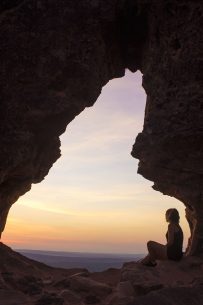
Tip: If you do end up being back from your day trip before sunset, the Tocatins river in Carolina is a good spot!
Pedra Caida
If you’re looking to fill a 3rd day, Pedra Caida is very cool as well. There is a downside however… This one is located on the grounds of a giant complex taking away some of the nature and making this trip quite expensive.
Firstly, you have to pay to enter the grounds. Next you have to pay to visit Pedra Caida, and if you want to visit other waterfalls on these grounds, take a cable car or go ziplining, you have to pay again. It is possible to only visit Pedra Caida and not pay for anything else. This makes it a half day trip however. So if you’re going by tour, coordinate with the agency. Another option is to just visit the waterfalls and not enter the complex itself. The other waterfalls are quite expensive as well however and it did not seem worth it for us as Pedra Caida really is the star here. So we decided to pay for Pedra Caida and the complex and enjoy the pool and waterslides during the afternoon.
Upon entering the complex, the guides will show you a video and explain a little about what there is to in the complex. We first visited Pedra Caida. In order to reach the cave with the waterfall you have to walk through the water at a canyon. Best to leave your bags and none-waterproof things at the boardwalk before entering the water. After visiting we went back, passed by a not-so-interesting hangbridge, had lunch at the restaurant and spend the rest of the day at the pool and waterslides.
Additional entry fees: Complex 60 rls (30 for students). Pedra Caida 60 rls (no student discount). Additional cost for everything else you might want to do here.

Itapecuru (Gemeas)
We also visited the Itapecuru (or Gemeas) waterfalls, but I can’t really recommend it. It’s more a place for locals to enjoy a sunday afternoon with their families then a place to be amazed and there are much better places out there. There are lots of people and restaurants right at the bottom. They even let you put your table and chairs in the water (it’s very shallow), so the falls seem to have become part of the restaurant decor rather than a natural spot.
There are other places like this, like cachoeira León (Lion waterfall), where you only pay 5 rls entry fee, which seems a lot more reasonable for a place like this. Do note that León is a very tiny waterfall, it can barely be clasified as one. The Gemeas are a lot bigger, but the feeling is the same.
Additional entry fee: 40 rls (20 for students).

This was the most amazing waterfalls in Brazil
If you want to read more about what Brazil has to offer, check out my article about the best beaches of Brazil’s northeast as well!

Share this:
- Click to share on Facebook (Opens in new window) Facebook
- Click to share on Pinterest (Opens in new window) Pinterest
- Click to share on WhatsApp (Opens in new window) WhatsApp
- Click to share on X (Opens in new window) X
- Click to print (Opens in new window) Print
- Click to email a link to a friend (Opens in new window) Email
